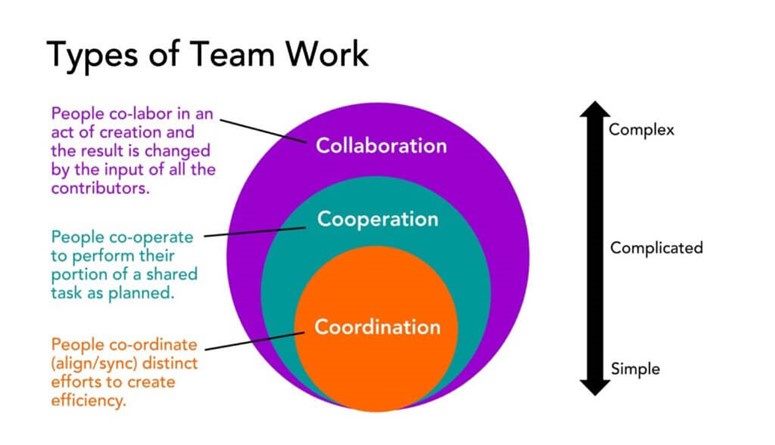Collaboration, coordination, cooperation: Thriving in the era of team-based work by differentiating teamwork types
- 7 Min Read
As organizations shift from hierarchical structures to team-based models, Britt Andreatta examines how to navigate teamwork types to avoid unproductive, dysfunctional teams with high levels of attrition
- Author: Britt Andreatta
- Date published: Nov 14, 2023
- Categories

Teamwork powers more and more of today’s work. Around the world, organizations are letting go of hierarchical structures and moving to teams-based models, with employees working in more agile and flexible small networks.
Innovation and web-based tools have enabled distributed teams to collaborate seamlessly, resulting in self-sufficient units that work across organizational and geographical boundaries. A survey of employees from 90 countries found that 89% of white-collar workers complete projects in global virtual teams, relying on online tools for communication. As a result, people are in 3 times more team meetings and calls per week than before.
Often, collaborating with teammates from different countries can be challenging due to time zones along with cultural and linguistic differences. In addition, coworking with physically distant colleagues can make building relationships feel forced rather than authentic.
Critical conditions for teamwork
What does it take to get teamwork right? A global study from Google illuminates what differentiates the highest-performing teams from the rest. It turns out that who is on the team matters less than how team members interact, communicate, and support each other. The findings validate what neuroscientists know: that humans are biologically wired to connect and collaborate. Engaging with each other can align our brain waves through neural synchrony, aiding our ability to communicate and interact productively. But first, team leaders must establish the critical conditions that drive peak performance at work.
Studies show that teams can take one of two paths: one to high performance or another to dysfunction and learned helplessness. Team leaders play a vital role in which path the team takes as their early meetings and actions influence and establish norms. Creating psychological safety and facilitating inclusion and belonging are central to success. Research shows that psychological safety is the key differentiator of high-performing teams, and leaders greatly influence how safe people feel as individuals and within a team. Finally, leaders also need to be familiar with the three types of teamwork and actively help teams succeed at each level.
Collaboration, coordination, and cooperation
Every day, organizations expect teams to navigate between coordination, cooperation, and collaboration, each representing different levels of complexity and requiring different skills. They exist on a continuum—explore the definitions and differences:
- Coordination is the orchestrated efforts of individuals or groups to align or synchronize separate actions. They exchange relevant information and resources in support of each other’s distinct goals. In other words, people coordinate (align/sync) distinct efforts (such as IT upgrading computers and facilities changing out desks) to create more efficiency, but they remain independent.
- Cooperation is the coordinated efforts of a group of two or more people to perform their assigned portion of an agreed-upon shared process or task. They are dependent on each other to execute a mutual objective. People co-operate to perform their portion of a shared task as planned. For example, IT works with Finance and Shipping to purchase and deliver new computers on time.
- Collaboration is the mutual engagement of a group of two or more in a co-creative effort that achieves a shared goal or vision. They are interdependent, with each unique contribution essential to the whole. People co-labor in an act of creation, and the input of all the contributors changes the result. An example would be several people and departments working together to shift an organization’s culture.

Coordination only requires basic communication and planning skills (though many people still need help). Cooperation requires a clear process for execution and accountability. And collaboration requires advanced skills: building trust, creativity, innovation, and mindful process for conflict resolution.
Developing teamwork skills
Many organizations could better help teams develop these skills so they are ready to perform successfully at any level of teamwork.
Leaders must also clearly communicate which type of teamwork they expect. Teams often need to switch back and forth between goals, intentions, and skill sets, which can be difficult when our work is blended throughout the day. We might be in a meeting at 9 a.m. to coordinate with another department, then go into another meeting where we must cooperate with two other groups, followed by a working project session that requires collaboration.
What does collaboration look like in your organization, and how often are you asking your teams to navigate between these different levels of work? For many organizations, the amount of time employees engage in collaborative work has increased by roughly 50%, and for some, it can comprise more than 80% of their time. Consider these questions to assess your organization:
- How well do your teams move across the teamwork continuum?
- Are you assigning collaborative work to the right teams?
- Do teams have access to training on the skills needed for success?
- Do your team leaders know how to create the right conditions for collaboration by helping people think and perform together?
Picking the right leaders
Organizations must also pick the right people to serve in team leadership roles. Often, the default is to select leaders based on their performance as individual contributions. But several studies find that the best individual performers often don’t make effective team leaders. They inevitably and unconsciously use the team to execute their own vision rather than creating the conditions for others to shine. Leading collaboration requires enhancing the strengths of others to co-create something new.
Organizations must choose team leaders based on their skills for creating an environment for others to collaborate. They must also provide the training to build leaders’ understanding of how to build and maintain psychological safety and trust as well as inclusion and belonging.
How teamwork dynamics shape HR and business outcomes
Organizations expect workers to perform complex tasks without ever meeting in person, often relying on computer screens for communication. But when relationship-building is shortchanged, it’s harder to build trust, which may lead to more conflict, decreased performance, and, ultimately, attrition.
When employees leave, teams take a hit, and organizations experience negative results such as declines in productivity, innovation, and quality. Research shows that the cost of replacing an employee can range from one-half to two times their annual salary, making dysfunctional teams very costly.
This is why teams are the most crucial entity in the workplace. When we set them up for success, teams can propel individuals and the organization forward. However, getting it wrong can impede an organization’s ability to compete or succeed. Gallup found that one in three employees has considered leaving their jobs because of negative team environments.
The data is clear. We are wired to connect with others, and when leaders are skilled in creating the conditions for optimal teamwork, teams and individuals can perform at their fullest potential.
Dr. Britt Andreatta is an internationally recognized thought leader who uses her background in leadership, neuroscience, psychology, and education to create science-based solutions for today’s workplace challenges. Britt is the CEO of Brain Aware Training and former CLO for Lynda.com (LinkedIn Learning). She has over 10 million views worldwide of her online courses and she regularly consults with organizations on leadership development and learning strategy. Britt is the author of several best-selling books on the brain science of success including Wired to Grow, Wired to Resist, Wired to Connect, and Wired to Become. In 2022, she was named a Top 10 Influencer in Learning, and in 2021, she was a Top 20 Learning Influencer and a Top 20 HR Influencer for Leadership Development









